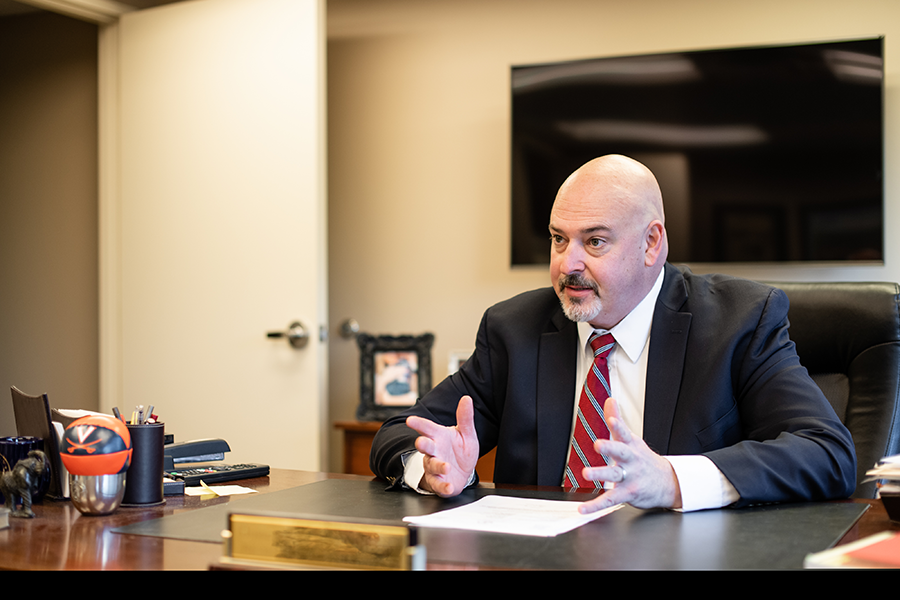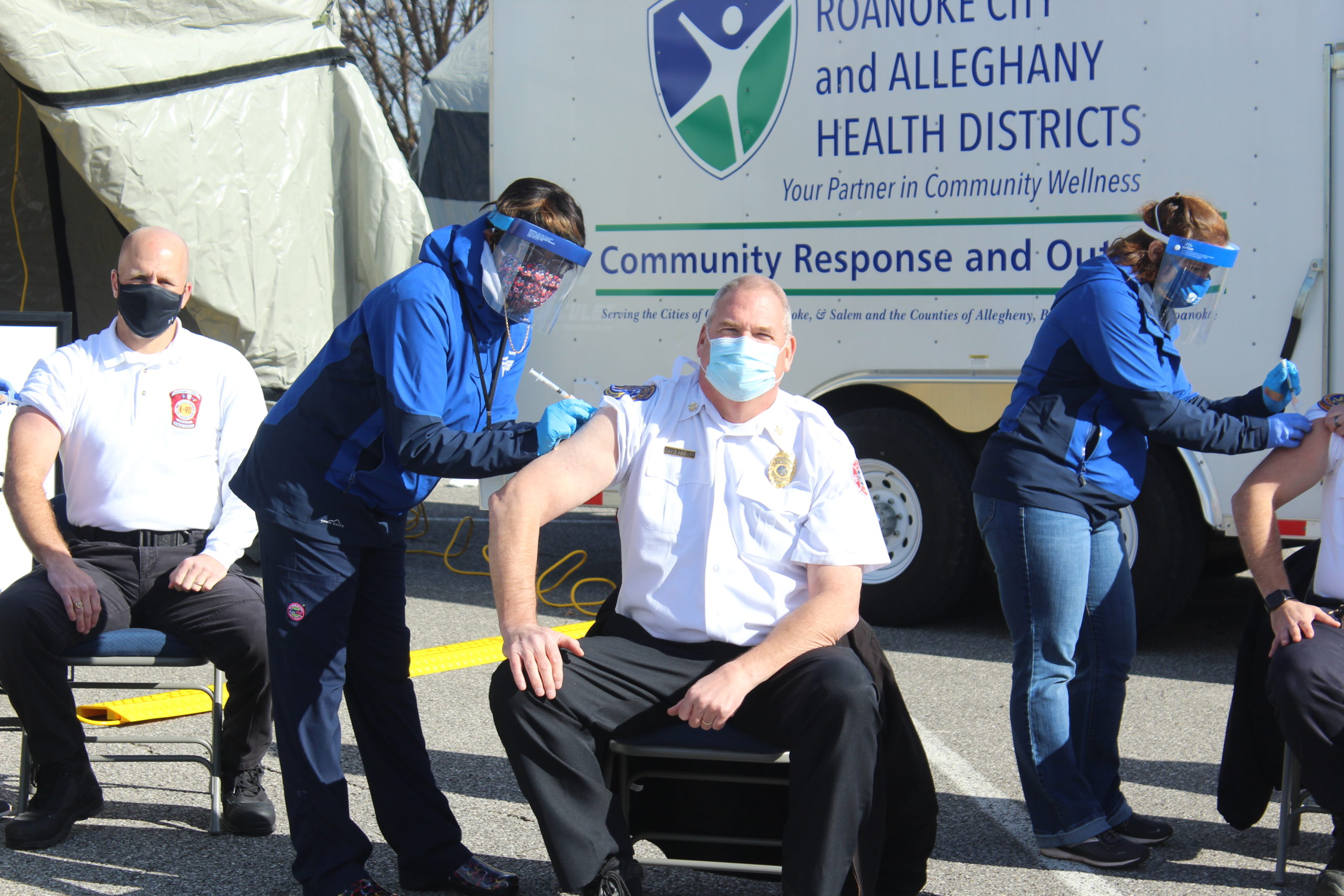Just after surpassing more than 5,000 coronavirus-related deaths, Virginia hit its highest daily average of new COVID-19 cases for the third day in a row.
As of Monday, the state’s seven-day average of new cases stands at a record high of 4,480. On Saturday, Jan. 2, the average was 4,168; on Sunday, Jan. 3, the average was 4,313.
As COVID-19 cases continue to surge following the holidays, some of America’s large metropolitan hospitals are feeling the strain, pushing occupancy limits and overwhelming staff. In Virginia, however, the situation doesn’t yet appear as dire.
According to Virginia Hospital & Healthcare Association spokesman Julian Walker, intensive-care unit beds are currently at 82% occupancy statewide; for comparison, 2019’s statewide average was 67%. With “surge beds” – beds repurposed for ICU use – factored in, he says, the state is currently operating at 55% ICU bed capacity.
“Capacity isn’t as much a concern,” says Walker, explaining that staffing may prove the greater issue due to health care workers becoming ill or quarantining due to an exposure; VHHA does not track figures on employees out of work because of the pandemic. “I wouldn’t say that we’re at a critical point in Virginia, but that doesn’t mean that things aren’t heading in an upward trajectory.”
Virginia recorded 31,361 new COVID-19 cases and 271 deaths last week, according to the Virginia Department of Health‘s Jan. 4 update. The current seven-day positivity rate is 15.8%, up 3.5% from a week ago, with an average of 4,480 new cases reported daily.
Walker says 2,765 patients in Virginia are currently receiving in-patient care for COVID-19, roughly 2,400 of which have confirmed positive tests — a leap of more than 1,100 hospitalized COVID patients over the past month.
“Hospitals certainly experienced a bump post-Thanksgiving, and the unfortunate expectation is that in the post-holiday period that there may be another bump, which leads to continued escalation in the number of cases, including the number of people that are hospitalized,” Walker says. “The concern is that if the numbers continue on this trajectory, that could become problematic.”
Dr. Nicolas Restrepo, vice president of medical affairs for Valley Health’s Winchester Medical Center in Winchester, says his health care system has worked to increase capacity.
In the spring, the system maxed out at 40 COVID-19 patients; two days ago, Valley Health reached a new high of caring for 148 individuals for COVID-19. Restrepo says PPE supply chain improvements and gains made in testing have helped increase their capacity.
Still, he says the pandemic is hard on his staff.
“It’s taxing,” says Restrepo. “It is definitely creating a lot of wear and tear on the staff and challenging their resilience. But they’re an incredible group of people, and they continue to move forward, and they continue to support one another, and they continue to provide tremendous care to their patients.”
The state has reported 367,536 cases and 5,132 deaths since March.
Meanwhile, 87,618 people in Virginia have received one dose of a COVID vaccine, and 404,675 doses from Moderna and Pfizer Inc. have been distributed as of Jan. 3, VDH reported. Two doses of each vaccine are required to be fully vaccinated.
In December, the Centers for Disease Control and Prevention issued guidance from a panel of doctors and public health experts, which set vaccination priorities that Virginia is following. After frontline care givers and long-term care facility residents and workers receive the vaccine, the next populations in line for COVID-19 vaccinations would be people ages 75 and older and about 30 million “frontline essential workers,” including grocery store workers, teachers and emergency responders. Others — including people age 65 to 74 and those with serious health conditions — will follow these groups, and Virginia public health officials expect the vaccines to be broadly available by summer 2021.
Until then, Walker stresses the need for resiliency.
“Everyone has pandemic fatigue, everyone wants this to be over,” Walker says. “There is hope in the form of the vaccine, but it’s still going to be months before the general public has access to the vaccine and months before a sufficient number of Americans have been vaccinated to reach the point of herd immunity.”
On Friday, Dr. Anthony Fauci, director of the National Institute of Allergy and Infectious Diseases, will take part in an online event open to the public, Facts & Faith Friday. He will be joined by Gov. Ralph Northam, State Health Commissioner Dr. Norman Oliver, VCU Massey Cancer Center Director Dr. Robert Winn and other state officials in a discussion about the COVID-19 vaccine. To register for the event, click here.
The following health districts reported positivity rates above 10% as of Dec. 31:
- Alexandria — 10.9%, up from 8.4% on Dec. 24
- Alleghany (Alleghany, Botetourt, Craig and Roanoke counties and the cities of Covington, Roanoke and Salem) — 13.7%, up from 11.6%
- Central Shenandoah (Augusta, Bath, Highland, Rockbridge and Rockingham counties and the cities of Buena Vista, Harrisonburg, Lexington, Staunton and Waynesboro) — 21.1%, up from 17.0%
- Central Virginia (Amherst, Appomattox, Bedford and Campbell counties and Lynchburg) — 24.3%, up from 17.1%
- Chesapeake — 22.7%, up from 17.8%
- Chesterfield — 15.6%, up from 13.6%
- Chickahominy (Charles City, Goochland, Hanover and New Kent counties) — 15.1%, up from 10.0%
- Crater (Dinwiddie, Greensville, Prince George, Surry and Sussex counties and the cities of Emporia, Hopewell and Petersburg) — 13.8%, up from 11.7%
- Cumberland Plateau (Buchanan, Dickenson, Russell and Tazewell counties) — 22.8%, up from 22.5%
- Eastern Shore (Accomack and Northampton counties) — 19.5%, up from 11.8%
- Fairfax — 14.5%, up from 10.5%
- Hampton — 21.8%, up from 15.4%
- Henrico — 13.2%, up from 8.9%
- Lenowisco (Lee, Scott and Wise counties and the city of Norton) — 32.4%, up from 21.4%
- Lord Fairfax (Clarke, Frederick, Page, Shenandoah and Warren counties and Winchester) — 14.7%, up from 14.4%
- Loudoun — 16.6%, up from 11.6%
- Mount Rogers (cities of Bristol and Galax and counties of Bland, Carroll, Grayson, Smyth, Washington and Wythe) — 23.4%, up from 20.6%
- New River (Floyd, Giles, Montgomery and Pulaski counties and Radford) — 15.9%, up from 11.7%
- Norfolk — 14.0%, up from 13.1%
- Peninsula (Newport News, Poquoson, Williamsburg, James City and York counties) — 16.6%, up from 13.1%
- Piedmont (Amelia, Buckingham, Charlotte, Cumberland, Lunenburg, Nottoway and Prince Edward counties) — 18.3%, down from 22.0%
- Pittsylvania-Danville — 19.1%, up from 12.4%
- Portsmouth — 19.4%, up from 18.5%
- Prince William — 20.8%, up from 17.2%
- Rappahannock (Caroline, King George, Spotsylvania and Stafford counties and Fredericksburg) — 17.6%, up from 12.3%
- Rappahannock Rapidan (Culpeper, Fauquier, Madison, Orange and Rappahannock counties) — 11.1%, up from 9.7%
- Richmond — 11.4%, up from 6.7%
- Roanoke — 18.2%, up from 16.8%
- Southside (Brunswick, Halifax and Mecklenburg counties) — 12.7%, up from 6.9%
- Three Rivers (Essex, Gloucester, King and Queen, King William, Lancaster, Mathews, Middlesex, Northumberland, Richmond and Westmoreland counties) — 14.4%, up from 13.4%
- Virginia Beach — 18.3%, up from 13.8%
- West Piedmont (Franklin, Henry and Patrick counties and the city of Martinsville) — 19.0%, up from 17.0%
- Western Tidewater (Isle of Wight and Southampton counties and the cities of Franklin and Suffolk) — 13.1%, up from 10.1%
These are the 10 Virginia localities that have seen the most cases in the state, as of Jan. 4:
- Fairfax County: 46,096
- Prince William County: 26,664
- Virginia Beach: 17,819
- Loudoun County: 14,569
- Chesterfield County: 13,658
- Henrico County: 13,126
- Chesapeake: 9,759
- Richmond: 9,635
- Arlington County: 9,290
- Norfolk: 9,169
Globally, there are 85.2 million reported COVID-19 cases and 1,845,408 confirmed deaths, as of Jan. 4. The United States, which has the most confirmed cases and deaths worldwide, has seen 20.6 million confirmed cases so far, with 351,590 deaths attributed to the coronavirus since February.





